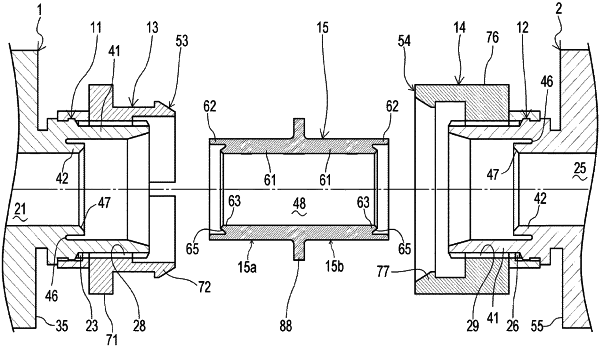| CPC F16L 37/098 (2013.01) [F16L 37/107 (2013.01)] | 4 Claims |

|
1. A fitting assembly for fluid device connecting a first fluid device with a second fluid device, comprising:
a first port being annular, integrated with a casing of the first fluid device as a single piece so that the first port cannot rotate independently of the casing of the first fluid device, connected with a first fluid channel of the first fluid device, and an outer periphery of the first port including a first thread;
a second port being annular, integrated with a casing of the second fluid device as a single piece so that the second port cannot rotate independently of the casing of the second fluid device, connected with a second fluid channel of the second fluid device, and an outer periphery of the second port including a second thread;
a first annular member installed at the first port, an inner periphery of the first annular member including a third thread configured to engage the first thread, the first annular member including
a first body fixed to the first port by the third thread engaged with the first thread, and
a first hook protruding axially from an axial end of the first body;
a second annular member installed at the second port, an inner periphery of the second annular member including a fourth thread configured to engage the second thread, the second annular member including
a second body fixed to the second port by the fourth thread engaged with the second thread, and
a second hook protruding axially from an axial end of the second body; and
a connector installed between the first port and the second port, sealing a gap between the connector and the first port, and sealing a gap between the connector and the second port, wherein
at least one of the first hook and the second hook is radially bendable, and circumferentially angular ranges of the first hook and the second hook around a common axis overlap each other regardless of what angle the first annular member rotates with respect to the second annular member around the common axis, and
when the first annular member is separated from and coaxially approaches the second annular member, one of the first hook and the second hook pushes away the other of the first hook and the second hook radially, and then the one of the first hook and the second hook is engaged with the other to prevent the first annular member and the second annular member from separating from each other.
|